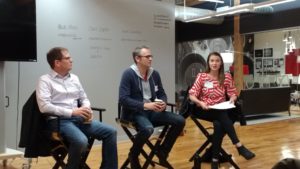Everyone knows that retail needs to transform to survive — but what does the store of the future look like?
At a recent Minnesota Interactive Marketing Association event at Rocket55, retail consultant Chris Walton described the store of the future as “one hell of a swingers party.”
Walton explained his analogy by sharing who would be at the party with actors and actresses representing different retailers:
- Amazon (George Clooney or Jennifer Aniston) — By using the visual search technology in the Amazon app, everything in the physical world is in Amazon’s inventory.
- Starbucks (Matt Damon or Amy Adams) — The coffeehouse does mobile payments exceedingly well.
- Bonobos (Julia Stiles or the WTF guest) — The chain was the first to start out with omnichannel marketing, and has a store in downtown Minneapolis without any inventory.
- IKEA (Angelina Jolie or the danger guest) — The home furnishings chain separated operations from shopping and fulfillment, and makes the customer do all the work.
- Italians, or everything in a casino (Joe Pesci or Talia Shire) — There needs to be a physical presence for a casino, with hosts who care that you have a great time. “Retail has to change to make you feel like a welcome guest,” said Walton. He added that no retailer really fits this now.
At the event, which also included retail consultants Anne Mezzenga and Rick Olson, Walton described the changes in retail as taking place in two ways:
- An incremental pivot — In this instance, the retailer tries something slightly new while keeping its current business model, such as Target Order Pickup.
- Completely new business model — Walton said that Amazon developing the Kindle is the best example of this, as that invention changed how Amazon sold books.
Mezzenga said that it’s challenging for legacy retailers to test out new concepts that are more than an incremental pivot, as there needs to be “support and runway for a test so a concept can emerge.”
Among the legacy retailers, Walton mused about what will come of Kohl’s, pointing out that the chain’s core demographic “means most likely that they won’t be in business 10 to 15 years from now.”
Whatever the store of the future becomes, it sure will be interesting to see it all unfold.

